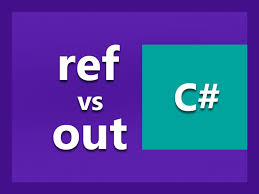In the realm of C# programming, the
refandoutkeywords serve as powerful tools for handling parameters in method calls.While they might seem similar, each plays a distinct role. In this blog post, we'll delve into the nuances of these keywords, exploring their applications and providing illuminating code snippets.
ref Keyword: Passing by Reference
The
refkeyword allows a method to modify the value of the parameter it receives. It facilitates two-way communication between the calling method and the called method.In this example, the
IncrementByRefmethod modifies the value of thenumberparameter, and the change is reflected in the calling method.out Keyword: Returning Multiple Values
The
outkeyword is used to pass a parameter by reference strictly for output purposes. It is often employed when a method needs to return multiple values.In this scenario, the
DivideAndRemaindermethod calculates both the quotient and remainder and returns them through theoutparameters.Key Differences:
Initialization Requirement:
ref: The variable must be initialized before being passed as arefparameter.out: The variable does not need to be initialized before being passed as anoutparameter.Method Initialization:
ref: The variable must be initialized before being passed to arefparameter.out: The variable can be uninitialized before being passed to anoutparameter.Return Values:
ref: The method can use the existing value of therefparameter.out: The method is expected to assign a value to theoutparameter; otherwise, it results in a compilation error.Call Site Initialization:
ref: The variable must be initialized before being passed to arefparameter.out: The variable can be uninitialized before being passed to anoutparameter.Conclusion
Understanding the distinctions between the
refandoutkeywords is essential for writing clean and effective C# code.While
refenables two-way communication, allowing the method to read and modify the variable,outis primarily used for returning multiple values from a method.Choosing the appropriate keyword depends on the specific requirements of the scenario. By mastering these keywords, developers can harness their full potential, resulting in more robust and efficient C# code.
These keywords might not be everyday tools, but when the need arises, their proper application can greatly enhance the expressiveness and functionality of your code. Happy coding!
RabbitMQ is a robust message broker that enables communication between services in a decoupled, reliable manner. In this guide, we’ll implement RabbitMQ in a .NET Core application to connect two microservices: Shopping Cart API (Producer) and Order API (Consumer). 1. Prerequisites Install RabbitMQ locally or on a server. Default Management UI: http://localhost:15672 Default Credentials: guest/guest Install the RabbitMQ.Client package for .NET: dotnet add package RabbitMQ.Client 2. Architecture Overview Shopping Cart API (Producer): Sends a message when a user places an order. RabbitMQ : Acts as the broker to hold the message. Order API (Consumer): Receives the message and processes the order. 3. RabbitMQ Producer: Shopping Cart API Step 1: Install RabbitMQ.Client Ensure the RabbitMQ client library is installed: dotnet add package RabbitMQ.Client Step 2: Create the Producer Service Add a RabbitMQProducer class to send messages. RabbitMQProducer.cs : using RabbitMQ.Client; usin...

Comments
Post a Comment